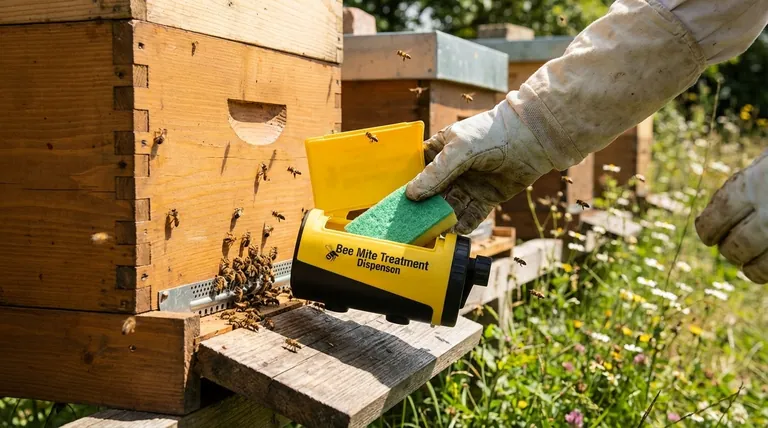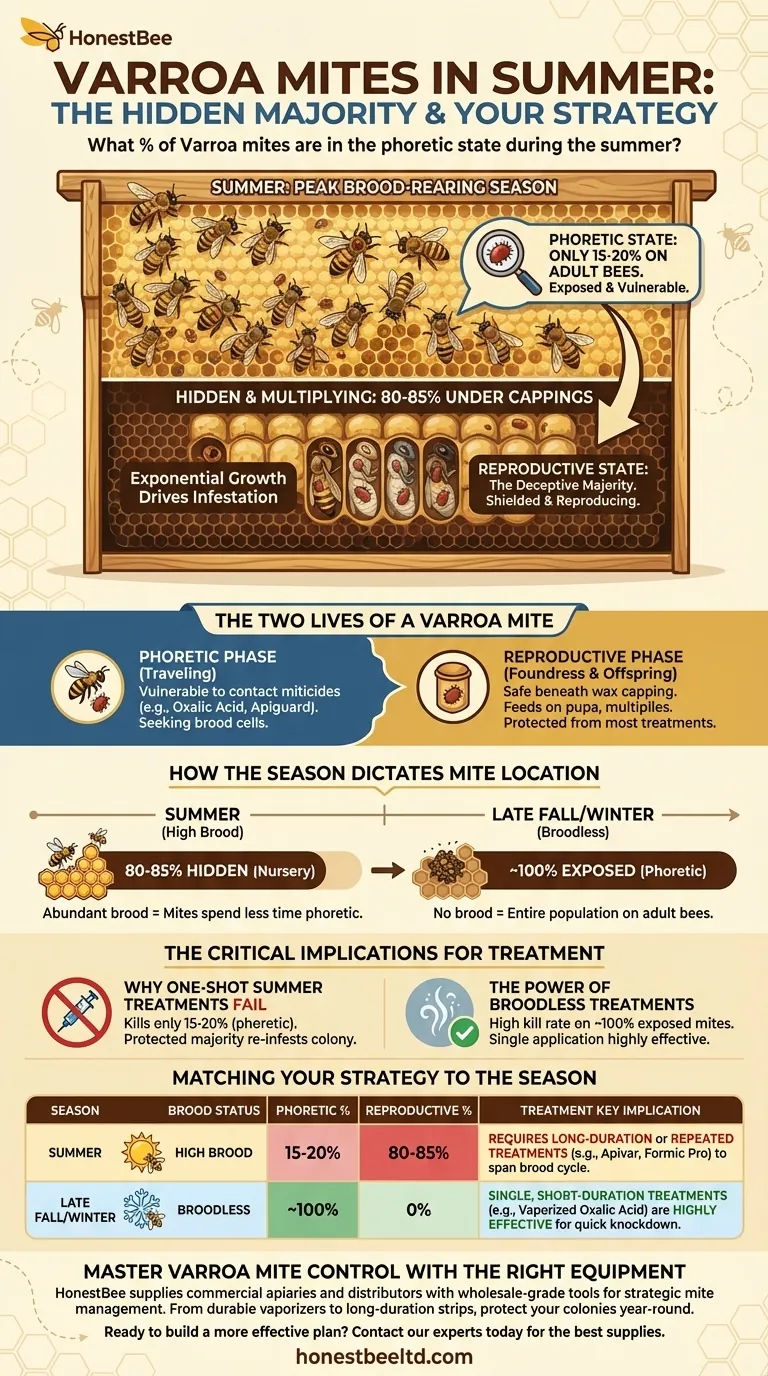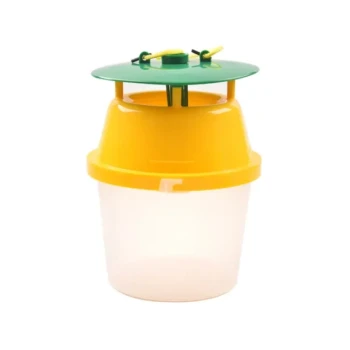In a typical summer honey bee colony, a surprisingly small percentage of Varroa mites are in the phoretic state. During this peak brood-rearing season, only about 15-20% of the total mite population is found on adult bees, while the overwhelming majority—80-85%—is hidden away, reproducing inside capped brood cells.
The small percentage of visible, phoretic mites during the summer is deceptive. The true threat lies with the vast, hidden majority of mites reproducing under brood cappings, a fact that must dictate your entire treatment strategy.

The Two Lives of a Varroa Mite
To understand Varroa management, you must first understand that the mite lives two distinct lives within the hive. The proportion of mites in each phase changes dramatically with the seasons and directly impacts the effectiveness of any treatment.
The Phoretic Phase: Exposed and Vulnerable
The word phoretic describes the phase when a mite is attached to an adult bee, feeding on its fat bodies and moving about the hive. This is the mite's "traveling" stage.
Mites in this phase are exposed. They are vulnerable to contact miticides like oxalic acid vaporization or Apiguard. However, a female mite's goal is to reproduce, so she remains in this state only as long as it takes to find a suitable brood cell to invade.
The Reproductive Phase: Hidden and Multiplying
This is the core of a Varroa infestation. A mature female mite (the "foundress") slips into a larva's cell just before the worker bees cap it.
Safe beneath the wax capping, she feeds on the developing bee pupa and lays a series of eggs. These offspring mature and mate within the sealed cell. When the young bee emerges, so do the original foundress mite and her newly mated adult daughters, ready to start the cycle again.
During this phase, mites are completely shielded from nearly all forms of treatment. This hidden, multiplying population is why Varroa is such a persistent threat.
How the Season Dictates Mite Location
The 15-20% figure is not a constant. It is a direct result of the honey bee colony's natural brood cycle.
Summer: The Mite Nursery
During the spring and summer, a healthy queen is laying eggs at her maximum capacity. This creates an enormous amount of brood, which is an enormous breeding ground for mites.
With an abundance of cells to invade, mites spend very little time in the phoretic phase. This is why 80-85% of the mite population is hidden under cappings, driving exponential growth.
Late Fall and Winter: The Broodless Period
As temperatures drop, the queen slows or completely stops laying eggs. The colony enters a broodless period.
With no available cells for reproduction, the entire mite population is forced into the phoretic state. Nearly 100% of the mites are on the adult bees, making the entire population vulnerable at once.
The Critical Implications for Treatment
Understanding this population shift is the difference between an effective mite treatment and a wasted effort.
Why "One-Shot" Summer Treatments Fail
Applying a single treatment that only kills phoretic mites—such as one oxalic acid vaporization—during the summer is highly ineffective. Such a treatment will kill only the exposed 15-20% of mites.
The protected 80-85% will emerge from their cells over the following days and weeks, immediately re-infesting the colony and continuing their growth.
The Logic of Long-Duration Treatments
This is precisely why summer treatments must have a long duration. Products like Apivar (amitraz strips) or Formic Pro (formic acid) are designed to release their active ingredient over time.
This extended action ensures they kill not only the mites present at the start but also the mites that emerge from capped cells throughout a full brood cycle.
The Power of Broodless Treatments
Treating a colony during a natural broodless period in late fall or early winter is exceptionally effective. Because all the mites are exposed, a single application of a miticide like vaporized oxalic acid can achieve a very high kill rate, drastically reducing the overwintering mite load.
Matching Your Strategy to the Season
- If you are treating in the summer (with brood present): Your strategy must account for the 80-85% of mites protected under cappings, requiring repeated applications or an extended-release treatment that spans a full brood cycle.
- If you are treating in the late fall or winter (broodless): Your strategy can leverage the fact that nearly 100% of mites are exposed, making a single, high-efficacy phoretic treatment exceptionally effective for a quick knockdown.
Understanding this simple seasonal mite distribution is the foundation of effective Varroa management and is essential for the long-term health of your colonies.
Summary Table:
| Season | Brood Status | % of Mites in Phoretic State (on adult bees) | % of Mites in Reproductive State (in brood cells) | Key Implication for Treatment |
|---|---|---|---|---|
| Summer | High Brood | 15-20% | 80-85% | Requires long-duration or repeated treatments to kill emerging mites. |
| Late Fall/Winter | Broodless | ~100% | 0% | Single, short-duration treatments (e.g., Oxalic Acid) are highly effective. |
Master Varroa Mite Control with the Right Equipment
Effectively managing the hidden mite population requires a strategic approach and reliable tools. At HONESTBEE, we supply commercial apiaries and beekeeping equipment distributors with the wholesale-grade supplies needed to implement these critical seasonal strategies.
From durable vaporizers for high-efficacy broodless treatments to long-duration miticide strips, our equipment helps you protect your colonies year-round.
Ready to build a more effective mite management plan? Contact our experts today to discuss the best supplies for your operation's needs.
Visual Guide

Related Products
- Adjustable Formic and Acetic Acid Dispenser for Bee Mite Treatment
- Varroa Easy Check Mite Tester Kit Counter Alcohol Wash Jar
- Black Plastic Beetle Barn Hive Beetle Trap for Beehives
- Professional Dual-End Stainless Steel Hive Tool for Beekeeping
- HONESTBEE Advanced Ergonomic Stainless Steel Hive Tool for Beekeeping
People Also Ask
- What is the focus of hive management during summer? Maximize Your Honey Harvest with Expert Tips
- What should beekeepers do to manage varroa mites effectively? Adopt a Proactive Monitoring Strategy
- What are the symptoms of Varroa Mite Syndrome (VMS)? Recognizing the Signs of Colony Collapse
- What does Chewed Down Brood (CDB) indicate in bee colonies? A Sign of Varroa Mite Infestation
- How can beekeepers ensure their hives survive the winter? A Guide to Colony Survival



















